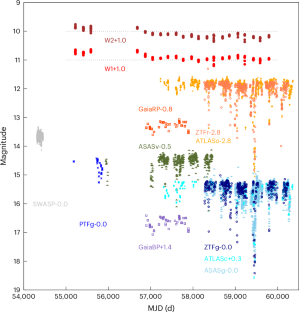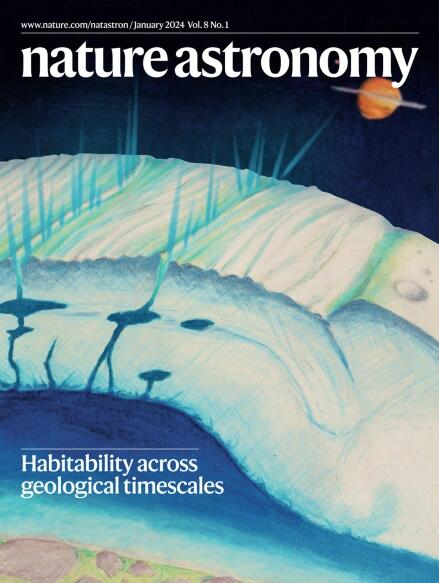行星状星云WeSb 1中心恒星周围轨道上的一群尘埃物体
IF 12.9
1区 物理与天体物理
Q1 ASTRONOMY & ASTROPHYSICS
引用次数: 0
摘要
系外行星和更小的天体已经被探测到围绕不同类型的恒星运行。然而,我们还不知道在行星状星云中有任何这样的天体,行星状星云是恒星演化的短暂阶段,介于渐近巨星分支和白矮星阶段之间。行星的活动(毁灭和形成)可能伴随着尘埃云。因此,我们利用档案光度数据搜索行星状星云中的尘埃掩星事件。我们显示PN WeSb 1的中心恒星具有许多持续数天至数周的典型变暗事件,其深度可达3等。这种变率主要是随机的,有400 d周期的迹象。掩星几乎是灰色的,表明尘埃颗粒大于0.1 μm。根据我们的后续观测,我们认为中央恒星是一个宽双星,这些事件很可能是由分裂的小岩石体的碎片引起的,这些小岩石体从前渐近的巨大分支恒星中逃脱出来,在伴星周围找到了安全的港湾。后一颗恒星支配着光谱,使我们能够看到日食。这意味着行星系统在行星状星云阶段存在并经历剧烈的演化。本文章由计算机程序翻译,如有差异,请以英文原文为准。


A swarm of dusty objects in orbit around the central star of planetary nebula WeSb 1
Exoplanets and smaller bodies have been detected orbiting different kind of stars. However, we do not know of any such objects in planetary nebulae, the short-lived stage of stellar evolution between the asymptotic giant branch and white dwarf phases. The planetary activity (destruction and formation) may be accompanied by dust clouds. Hence, we searched for dust occultation events in planetary nebulae using archival photometric data. We show that the central star of PN WeSb 1 features numerous dimming events with typical durations of a few days to weeks that are up to 3 mag deep. This variability is mainly stochastic with an indication of a 400 d period. The occultations are almost grey, indicating dust grains larger than about 0.1 μm. Based on our follow-up observations, we argue that the central star is a wide binary and that these events are most probably caused by debris from disintegrated small rocky bodies that escaped from the former asymptotic giant branch star to find safe harbour around the companion star. The latter star dominates the optical spectrum enabling us to see the eclipses. This means that planetary systems are present and undergo violent evolution during the planetary nebula stage. Numerous eclipses have been observed towards the binary central star of planetary nebula WeSb 1, probably caused by debris from disintegrated rocky bodies. This finding suggests that planetary systems undergo a violent evolution during the planetary nebula stage.
求助全文
通过发布文献求助,成功后即可免费获取论文全文。
去求助
来源期刊

Nature Astronomy
Physics and Astronomy-Astronomy and Astrophysics
CiteScore
19.50
自引率
2.80%
发文量
252
期刊介绍:
Nature Astronomy, the oldest science, has played a significant role in the history of Nature. Throughout the years, pioneering discoveries such as the first quasar, exoplanet, and understanding of spiral nebulae have been reported in the journal. With the introduction of Nature Astronomy, the field now receives expanded coverage, welcoming research in astronomy, astrophysics, and planetary science. The primary objective is to encourage closer collaboration among researchers in these related areas.
Similar to other journals under the Nature brand, Nature Astronomy boasts a devoted team of professional editors, ensuring fairness and rigorous peer-review processes. The journal maintains high standards in copy-editing and production, ensuring timely publication and editorial independence.
In addition to original research, Nature Astronomy publishes a wide range of content, including Comments, Reviews, News and Views, Features, and Correspondence. This diverse collection covers various disciplines within astronomy and includes contributions from a diverse range of voices.
 求助内容:
求助内容: 应助结果提醒方式:
应助结果提醒方式:


